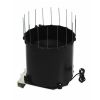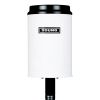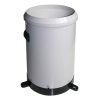Solinst Rainlogger 5 Rain Gauge Data Logger
The Solinst Rainlogger 5 is an inexpensive datalogger designed to record the tips of a standard tipping bucket rain gauge with a reed switch output.
Features
- Single-eye optical interface that is easy to clean and more scratch-resistant
- Increased memory: 150,000 sets of data
- Double o-ring seals for increased leakage protection
- Free ground shipping
- Expedited repair and warranty service
- Lifetime technical support
- More
Overview
The Rainlogger 5 is an inexpensive datalogger designed to record the tips of a standard tipping-bucket rain gauge. This compact and durable field unit offers long-term reliability and convenience with a battery that lasts up to 10 years and ESD (electrostatic discharge) protection with an ABS housing. The event timestamp and total rainfall per period is logged in non-volatile memory, which holds up to 100,000 readings. Sampling is event-based, as the Rainlogger 5 records and saves each tip of the tipping bucket as it happens.
Intuitive Levelogger Software
Levelogger customers can add rainfall data to their water level monitoring networks using the intuitive Levelogger Software. The Rainlogger 5 provides easy incorporation of precipitation data into existing Levelogger data. Rainfall data can correlate precipitation events and changes in groundwater or surface water levels. The Rainlogger 5 is compatible with all Solinst Levelogger 5 communication and deployment accessories. Logged data can be downloaded directly to a PC, using the Solinst Levelogger App, or a DataGrabber 5 data transfer device.
Interactive
The Rainlogger 5 is simply programmed with the user-friendly Levelogger Software. A Field Reader 5 or Desktop Reader 5 connects the Rainlogger 5 to a laptop or desktop PC, and the Levelogger Software automatically detects the attached Rainlogger. The Rainlogger 5 is easily deployed in the field, using a 3-pin connector cable attached to the rain gauge. Data downloading can be "All Data," "Append Data," or "Data Dump" at any time. Data can be displayed in graph or table format and exported to other programs. The Rainlogger 5 has self-test capability, reliable memory and the ability to upgrade firmware.
- (1) Solinst Rainlogger 5
- (1) Cable with flying leads, 6 ft.
In The News
Source Water Monitoring in Albany, New York: Tracing Water Quality throughout Tributaries
Thousands of US cities pull their drinking water from natural source waters like reservoirs, rivers, and streams, making overall watershed health a key consideration for water providers. In Albany, New York, the Albany Department of Water and Water Supply delivers drinking water to over 100,000 residents as well as monitors and manages the larger drinking water supply watershed. Hannah Doherty, Environmental Specialist at the Albany Department of Water and Water Supply , spends her days working with a small team to monitor the drinking supply and the connected water bodies. Doherty explains, “We’re the first to encounter the water that ends up being the drinking water.
Read MoreWildfire Prevention in the Sierra Nevada Region with the Yuba Watershed Institute
Though recent wildfires have sparked new conversations about wildfire management and response, groups like the Yuba Watershed Institute have been monitoring the forests and water resources of the Sierra Nevada region for decades, managing approximately 5,000 acres of land with the Bureau of Land Management (BLM) and about 7,000 acres in private land partnerships. The goal of the Institute is to work with local communities and land agencies to improve watershed and forestry management through informed practices and public outreach. The goals of the Yuba Watershed Institute are three-fold: Improve the ability of fire suppression agencies like the California Department of Forestry and Fire Protection ( CAL FIRE ) and the US Forest Service.
Read MoreWave Sensors Integration with NexSens Buoys: A Cutting-Edge Solution for Wave Measurment
Real-time wave data supports accurate weather prediction, safe and efficient maritime operations, and provides valuable safety and operating condition information for recreation and commercial fishing. Understanding wave dynamics also helps with the design of protective coastal structures like seawalls, breakwaters, and jetties. It also supports better prediction of their impact on sediment transport and coastal geomorphology. Wave data is a key factor in qualifying and designing offshore wind farms and harnessing kinetic energy for electrical generation. It helps with the understanding of ocean-atmosphere interactions and contributes to studies of sea-level rise and climate change impacts.
Read More

































